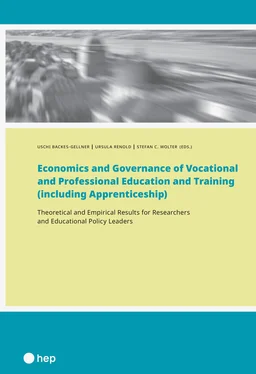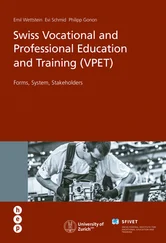The book analyzes the three most important actors and institutions for VPET: firms, individuals, and the state and institutional frameworks (i.e., national governance structures and institutions). The decisions and interactions of these three actors are critical for a successful and well-functioning national VPET system. The book analyzes their decisions from the perspectives of economics, management, and systemic governance.
In Chapter 2, “ Socially Constructed Concepts—Methodological Problems in Comparing VET Programs,” Ursula Renold elaborates on the challenges involved in internationally comparing education and training systems and the theoretical foundations of solving those problems. Identifying and understanding the socially constructed concepts used in most social science studies is a necessary prerequisite for comparing VPET systems. The chapter introduces the problem of country-specific terminology used for designating socially constructed concepts such as “apprenticeship.” The chapter discusses the problems inherent in the terms used in research papers and official documents, and suggests critically questioning the extent to which results of studies based on certain socially constructed concepts may be relevant in other societies. By identifying the functional equivalents within a specific unit of analysis—in this case, a VET program—the chapter provides an analytical framework for examining the main functions underlying strong VPET systems across contexts.
In Chapter 3, “ Firms,” the book investigates the role of firms as the supplier of apprenticeship training and thus an essential element of dual VET. Without the participation of firms, a dual VET system cannot exist. Firms providing job openings for apprenticeship training (hereafter, “training places”) fulfill three main functions: First, they are responsible for and carry out apprenticeship training. Second, they make a financial commitment to pay for both the training services and apprentices’ wages. Third, in most cases, they recruit and select the apprentices themselves. With the recruitment of the right number and type of apprentices for a specific occupation, firms fulfill a main task of a functioning VET system. For policy makers who want to create a successful dual VET system, the important questions to answer are thus when and under what conditions are firms willing to assume these responsibilities and provide a sufficient number and quality of apprenticeship training places.
To answer the question on when and under what conditions firms are willing to offer apprenticeship training, the papers presented in Chapter 3look primarily at the cost-benefit ratio. During apprenticeship training, firms bear costs in terms of the wages of the apprentices, the costs of the training personnel, and other expenses (e.g., materials). At the same time, firms achieve a return on their investments in the form of the apprentices’ productive contribution. Important for the willingness to train is the relationship of the costs and benefits, that is, the net costs or net benefits of apprenticeship training. With net benefits, firms are of course more willing to train. Yet even with net costs, firms may be willing to train if they are able to generate other long-term benefits from participating in apprenticeship training. Firms can benefit from apprenticeship training after the training period by hiring their highly skilled VET graduates as employees, by saving recruitment costs, and by additional positive effects of VET workers, such as innovation or reputation.
The empirical results in Chapter 3show that in Switzerland both on average and the majority of training firms achieve a net benefit during apprenticeship training ( Wolter, Muehlemann, & Schweri, 2006). Although training firms bear some costs during apprenticeship training (wages of apprentices, costs of training personnel, etc.), the productive contribution of apprentices is considerable—and for most firms large enough to offset these costs.
However, the empirical results in Chapter 3also show that, in addition to the short-term benefits of training, there are also non-negligible longer-term benefits. Backes-Gellner and Tuor (2010)show, for example, that apprenticeship training is a clear signal for high-quality workplaces and good career prospects, and that apprenticeship training therefore increases firms’ recruitment success from the external labor market. Backes-Gellner, Rupietta, and Tuor Sartore (2017)show that having VET graduates among a firm’s workforce also increases the productivity of other types of workers, e.g., those with a university degree. Moreover, VET makes a significant contribution to a firm’s ability to innovate and to its innovation outcomes ( Rupietta & Backes-Gellner, 2019; Bolli, Renold, & Woerter, 2018). By participating in apprenticeship training, small firms in particular gain access to important knowledge from the innovation frontier, because that knowledge is embedded in the regularly updated training curricula. An important prerequisite for this relationship is the participation of firms from the innovation frontier in a regular updating process, one that takes place in both Switzerland and Germany (for more information, see Backes-Gellner, U., & Pfister, C. 2020).
Yet, Wolter, Muehlemann, and Schweri (2006)also show that non-training firms in Switzerland—in comparison to similar training firms—would not have the same cost-benefit ratios were they to provide apprenticeship training. Instead, the empirical results show that non-training firms would typically end up with net costs. The main reason for the net costs are lower benefits because these firms do not have enough (skilled) work for apprentices (due to, for example, the business cycle or the size of the firm). These results help explain their decision not to train and points out the difficulties that countries should consider as they attempt to initiate dual VET systems and need to recruit training firms.
Conversely, the results for Germany also show that there may be different equilibria from the firm’s perspective: Even the average training firm ends up with net costs during apprenticeship training and a country comparison points towards possible explanations ( Dionisius et al., 2009; Muehlemann et al., 2010). For example, German apprentices spend a great deal of time on non-productive training activities, thereby reducing benefits during the training period. This result is consistent with the finding that most training firms in Germany follow an investment training strategy, recouping training costs only after the training period by retaining graduates and using them in highly productive workplaces. This approach only works if the firms find mechanisms for keeping their trained workers and avoiding poaching. Mohrenweiser, Zwick, and Backes-Gellner’s (2019)empirical results on poaching show that German firms are indeed mostly able to retain their apprentices, and that poaching is not widespread in Germany. Alternatively, another empirical study shows that one means of retaining apprenticeship graduates is to use performance pay components ( Rinawi & Backes-Gellner, 2020).
Taken together, these comparisons of Switzerland and Germany clearly show that a well-functioning VPET system is possible in different institutional contexts and with different governance structures. However, each country must have a sustainable equilibrium that allows firms to recoup training costs either during or after the apprenticeship training phase.
Recent research uses simulation models to calculate training costs and benefits for firms in countries that do not yet have a (functioning) dual VET system ( Chapter 3.12). The results identify the challenges that arise if the apprentice wage is too high, if the skill premium (skilled vs. unskilled worker) is too low, or if recruitment of skilled workers from the labor market is too easy. Thus, these hurdles have to be overcome on the way to a functioning VET system (see Muehlemann, Wolter, & Joho, 2018; Wolter & Joho, 2018; Wolter & Muehlemann, 2015).
Читать дальше












